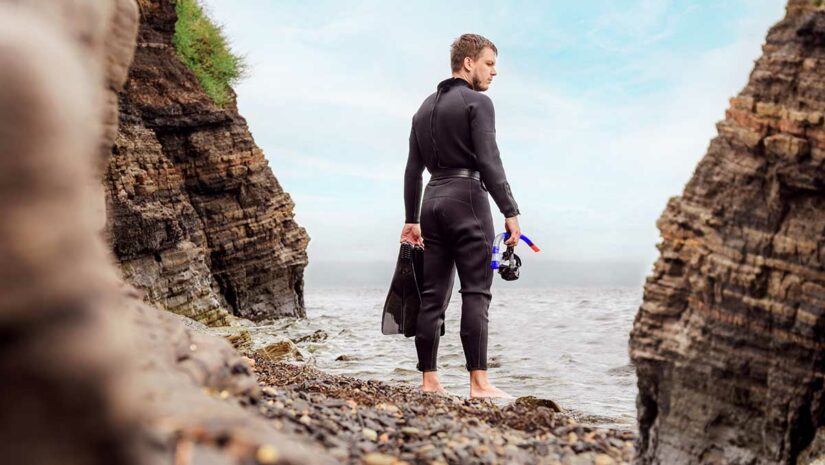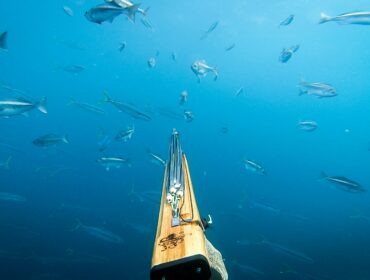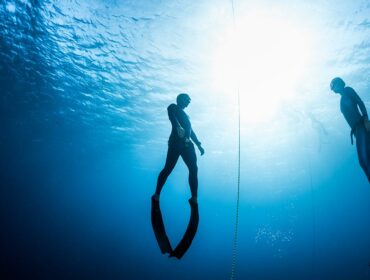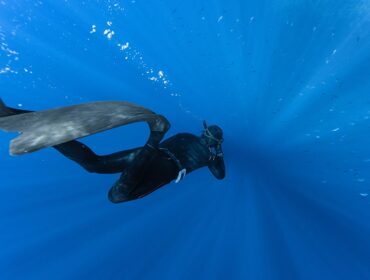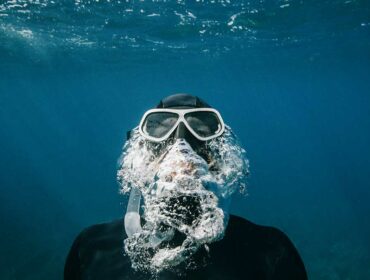Freediving is not just a sport; it’s a dance with the sublime silence of the underwater world, a return to our primal state of being. Among the essential freedive gears that make this serene sojourn possible, the freediving snorkel stands out as the silent companion that breathes life into our aquatic explorations. This humble yet pivotal tool is a freediver’s conduit to the air above while embracing the depths below. In this blog, we’ll dive deep into the world of freediving snorkels, exploring their design, functionality, and the role they play in harmonizing our breath, body, and the marine environment we yearn to be a part of. Whether you’re a seasoned freediver or just dipping your toes in the water, understanding the snorkel is key to unlocking the full potential of your underwater adventure.
Understanding the Freediving Snorkel
A snorkel is an essential piece of equipment for freediving, serving as a lifeline for breathing at the surface before and after dives. However, not all snorkels are created equal, and freediving snorkel features have distinct attributes that set them apart from regular snorkels.
The difference between freediving snorkels and regular snorkels
Freediving snorkels differ from regular snorkels in several key ways:
- Profile and Size: Freediving snorkels are typically designed with a low profile to reduce drag and resistance in the water. They are often slimmer than regular snorkels.
- Tube Flexibility: The tubes of freediving snorkels are usually more flexible, allowing them to bend or be folded away when not in use, which is not as common in regular snorkels.
- Mouthpiece: The mouthpieces on freediving snorkels are designed to minimize jaw fatigue, allowing for a more comfortable bite for longer periods. Regular snorkels might not have this level of ergonomic design.
- Valves: Freediving snorkels generally do not have purge valves as they add bulk and complexity. Regular snorkels often include valves to help clear out water more easily.
- Material: Freediving snorkels are often made of higher quality materials that can withstand the constant pressure changes and extended exposure to saltwater without degrading.
These differences make freediving snorkels more suitable for the specific demands of diving deep and staying underwater for prolonged periods, focusing on efficiency and comfort.

Benefits of Using the Correct Snorkel in Freediving
Choosing the right snorkel for freediving is not just a matter of comfort but also of performance and safety. Here’s how the correct snorkel can enhance your freediving experience:
Hydrodynamics and Reduced Drag
Hydrodynamic snorkel for freediving is designed specifically for freediving, with its slim and hydrodynamic profile, cuts through the water effortlessly, greatly reducing drag. A snorkel that boasts reduced drag translates to less energy expended during descent and ascent, allowing divers to conserve oxygen and extend their time underwater.
Thus streamlined snorkels for freediving are valued for speed and efficiency.
Easier Breath-ups on the Surface
The surface interval is a critical time for freedivers to relax and prepare for the next dive. A snorkel with a comfortable mouthpiece and an efficient airway design ensures that the diver can breathe deeply and calmly, which is essential for oxygen replenishment and carbon dioxide expulsion.
Improved Comfort and Reduced Jaw Fatigue
A key benefit of a quality freediving snorkel is the improved comfort. The right snorkel will have a mouthpiece made of soft, flexible material that fits comfortably, reducing the risk of jaw fatigue. This is a significant consideration for freedivers, as jaw discomfort can distract from the focus required for a successful dive. Thus, freediving snorkel with ergonomic design means that the diver can hold it in their mouth for extended periods without discomfort, as they concentrate on their technique and the world around them.
Different Types of Snorkels for Freediving
Freediving, an exhilarating underwater adventure, requires equipment that complements the diver’s need for efficiency and comfort. The snorkel, a pivotal piece of gear, comes in various forms tailored for the sport.
Classic J-Style Snorkels
When exploring the different types of snorkels suitable for freediving, the Classic J-Style snorkel remains a top choice among purists. These snorkels boast a timeless design characterized by their simple, straight tube without unnecessary features that can cause drag. Their minimalist design is highly regarded for its reliability and ease of use, offering seamless breath-ups during surface intervals. With no moving parts, the maintenance is straightforward, making it a durable option for freedivers who prefer a no-fuss solution for their underwater explorations.
Flexible Tube Snorkels for Deep Diving
These snorkels incorporate a flexible section that allows the mouthpiece to drop away from the face when not in use, reducing jaw fatigue and ensuring a more comfortable dive. The adaptability of the tube reduces resistance, which is crucial when conserving energy for deep dives.
Snorkels with and Without Purge Valves
The debate between snorkels with purge valves vs. traditional no-valve snorkels for freediving is ongoing in the freediving community. Snorkels equipped with purge valves offer the convenience of easily expelling water from the tube with a simple exhale, which can be appealing for beginners. However, some advanced freedivers opt for snorkels without purge valves to avoid the risk of malfunction at depth and to reduce the snorkel’s overall profile, thus minimizing drag.
Semi-Dry and Dry Snorkels
While not traditional for freediving due to their bulkier design, semi-dry and dry snorkels are sometimes used by freedivers who prioritize keeping water out. Semi-dry snorkels feature a splash guard that reduces water entry from waves while dry snorkels go a step further with a mechanism that seals the snorkel’s top upon submersion.
Custom and Therapeutic Snorkels
For those seeking a tailored experience or specific therapeutic benefits, custom and therapeutic snorkels are available. Custom snorkels are designed to fit individual facial structures and preferences, ensuring maximum comfort and performance. Therapeutic snorkels might include features that help with equalization or jaw relaxation.
Each type of snorkel serves different freedivers’ preferences, and the choice often comes down to personal comfort, the ease of clearing water, and the desire for a streamlined profile.
See below for some of our top Freediving Snorkels from brands including Cressi, Omer and Seac:
How to Choose the Right Snorkel for Freediving
Considerations such as Fit, Comfort, and Personal Preference
When embarking on the selection of the right snorkel for freediving, several considerations come into play to ensure that the snorkel you choose enhances your diving experience rather than detracts from it.
The fit of the snorkel is paramount. It must create a good seal with your mouth without causing any discomfort. If the fit isn’t quite right, you may find yourself distracted by water ingress or discomfort, which can disrupt your focus and breathing technique. Comfort extends to how the snorkel feels in your mouth over extended periods, as any irritation or strain can cause jaw fatigue, potentially cutting your dive short. Personal preference is also a critical factor. Some divers prefer a firm mouthpiece that feels secure, while others opt for something softer for comfort. The snorkel’s buoyancy is also a matter of preference—some divers like their snorkels to float, while others don’t mind if it sinks slowly if released.
Recommendations for Different Face Shapes and Sizes
Not all snorkels are suitable for all face shapes and sizes. A snorkel that is too long or too short can be uncomfortable and inefficient. Those with smaller faces might find a snorkel with a smaller mouthpiece more comfortable, which would not extend too far into the mouth and cause gagging. Conversely, individuals with larger faces might need a snorkel with a longer tube to breathe comfortably without straining. The curvature of the snorkel should also match the contour of your head to prevent it from sticking out, which can create drag.
Tips for Testing Snorkels Before Purchase
Testing snorkels before purchase can save you from a poor investment. If possible, test the snorkel in a pool or calm shallow water. Pay attention to how it feels in your mouth—is the mouthpiece too large or too small? Does it cause any strain on your jaw? Test the snorkel’s ease of breathing by taking regular, deep breaths. Check if the snorkel’s buoyancy matches your preference; does it float if you let go of it in the water? It’s also helpful to test the snorkel with the mask you’ll be using to ensure they fit well together. Lastly, simulate movements you would do while freediving to see if the snorkel stays in place or flaps around, which could be a distraction when you’re trying to focus on your dive.
In choosing the right snorkel for freediving, it’s crucial to consider the interaction of all these elements—fit, comfort, personal preference, and testing before purchase—to find the snorkel that feels like an extension of yourself in the water.
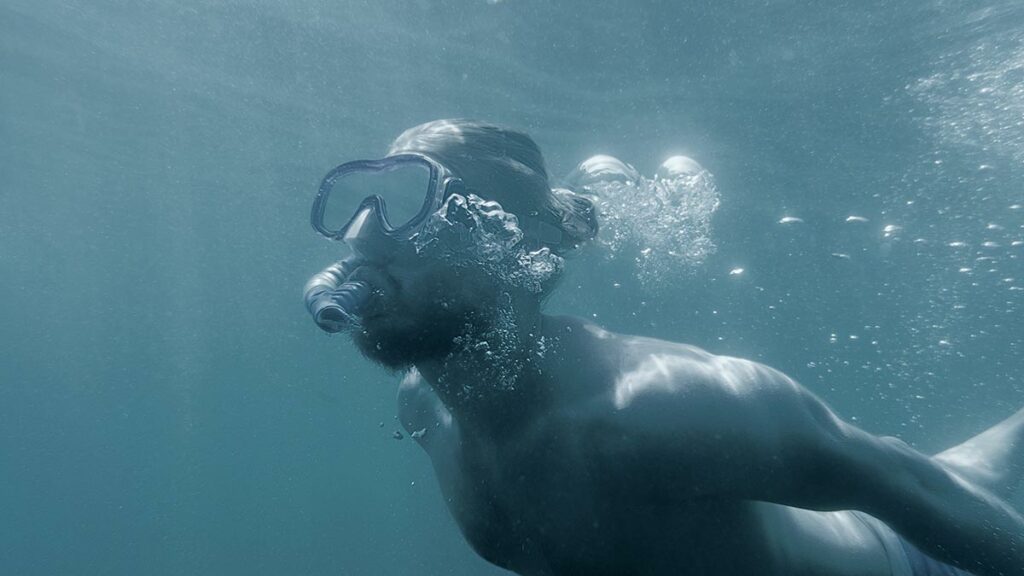
Care and Maintenance of Freediving Snorkels
Proper care and maintenance are essential to ensure the longevity and optimal performance of your freediving snorkel. Here’s how to keep your snorkel in top condition:
Cleaning and Storage Advice
After each use, it is crucial to rinse your snorkel thoroughly with fresh water to remove salt, chlorine, and other debris, which helps prevent material degradation. For a deeper clean, especially after use in saltwater, consider soaking the snorkel in a warm water solution with mild dish soap to dissolve salt crystals and other build-ups. Ensure it is completely dry before storage to prevent mold and mildew growth. Store your snorkel in a cool, dry place out of direct sunlight, as UV rays can deteriorate the silicone and plastic components over time.
Durability Tips
To maintain the snorkel’s durability, avoid leaving it in extreme temperatures, such as a hot car or in freezing conditions, which can cause the materials to become brittle or lose their flexibility. Also, keep it away from sharp objects or heavy items that could cause deformation or damage. When packing, place the snorkel in a dedicated compartment or a protective case to keep its shape intact. Regular checks for signs of wear, such as cracks or discoloration, especially around the mouthpiece and attachment points, can prevent unexpected failures during a dive.
When to Replace Your Snorkel
Inspect your snorkel regularly for any signs of wear and tear. If the mouthpiece shows signs of cracking or stiffness, it should be replaced to maintain comfort and safety. Likewise, if the tube has any damage or has become permanently misshapen, it’s time for a new snorkel. Another sign that you should replace your snorkel is if the attachment mechanism has become loose or no longer secures the snorkel adequately to the mask
Incorporating these care and maintenance tips into your routine will help ensure that your freediving snorkel remains a reliable companion on your underwater adventures. By doing so, freedivers can extend the life of their freediving equipment, allowing them to focus on the enjoyment and challenge of the sport rather than gear concerns.
Conclusion
In conclusion, the journey to selecting the right snorkel is as crucial as the dive itself. It’s a personal choice that directly influences your comfort, performance, and safety beneath the waves. A snorkel that is harmonious with your movements and breathing can elevate your freediving experience, transforming it from merely diving to truly becoming one with the ocean.
Therefore, investing in a quality snorkel that meets your specific needs is not just an expense; it’s an investment in countless dives to come, each with the potential to be more memorable than the last. As you continue to explore the depths and delights of freediving, let your snorkel be a trusted companion that enhances, rather than detracts from, the sublime serenity of the underwater world.

